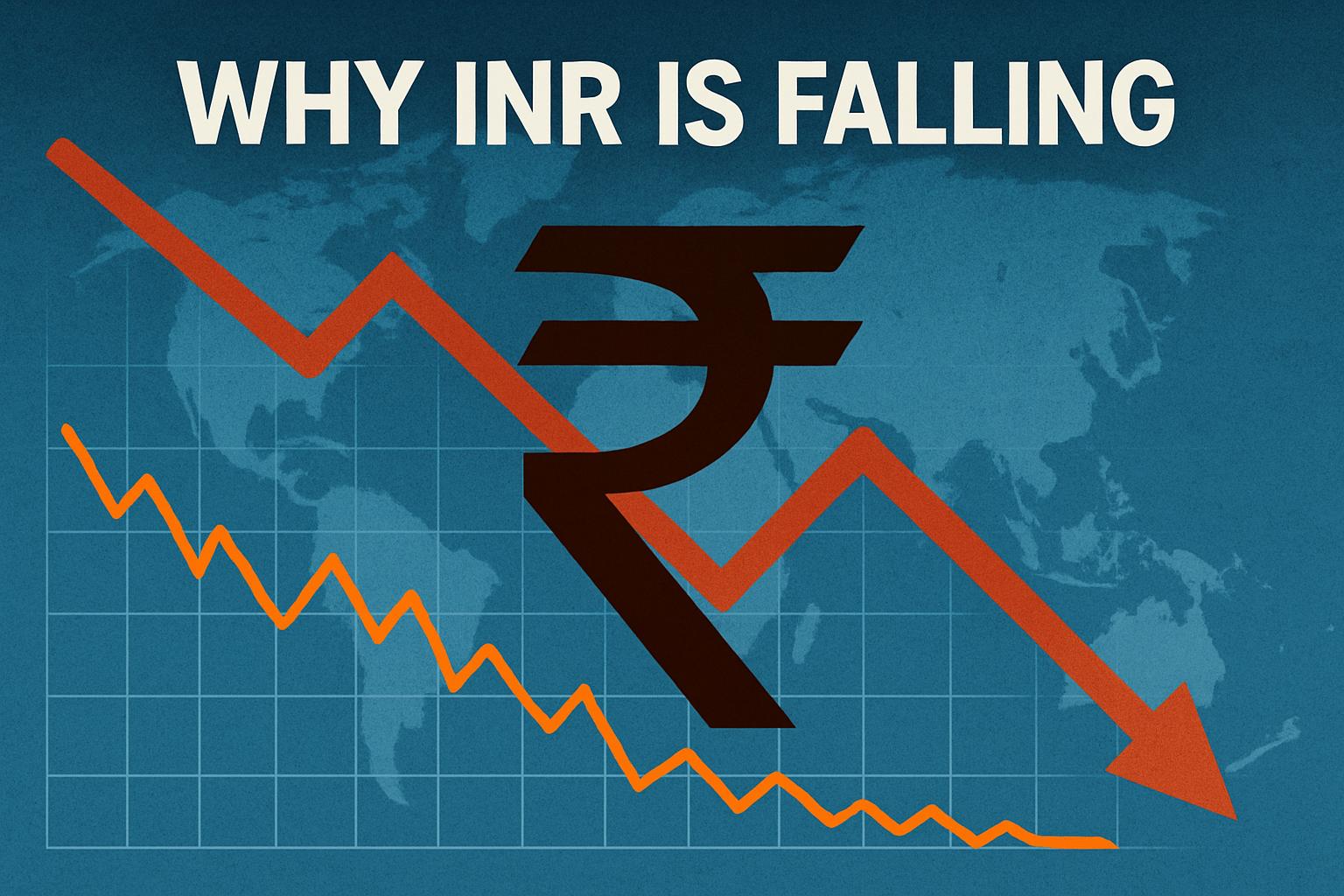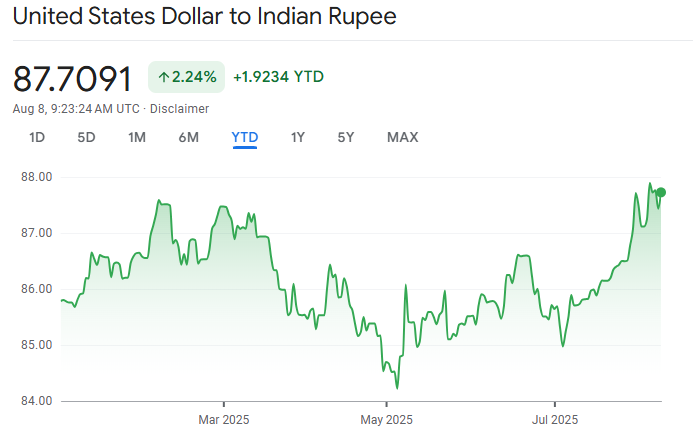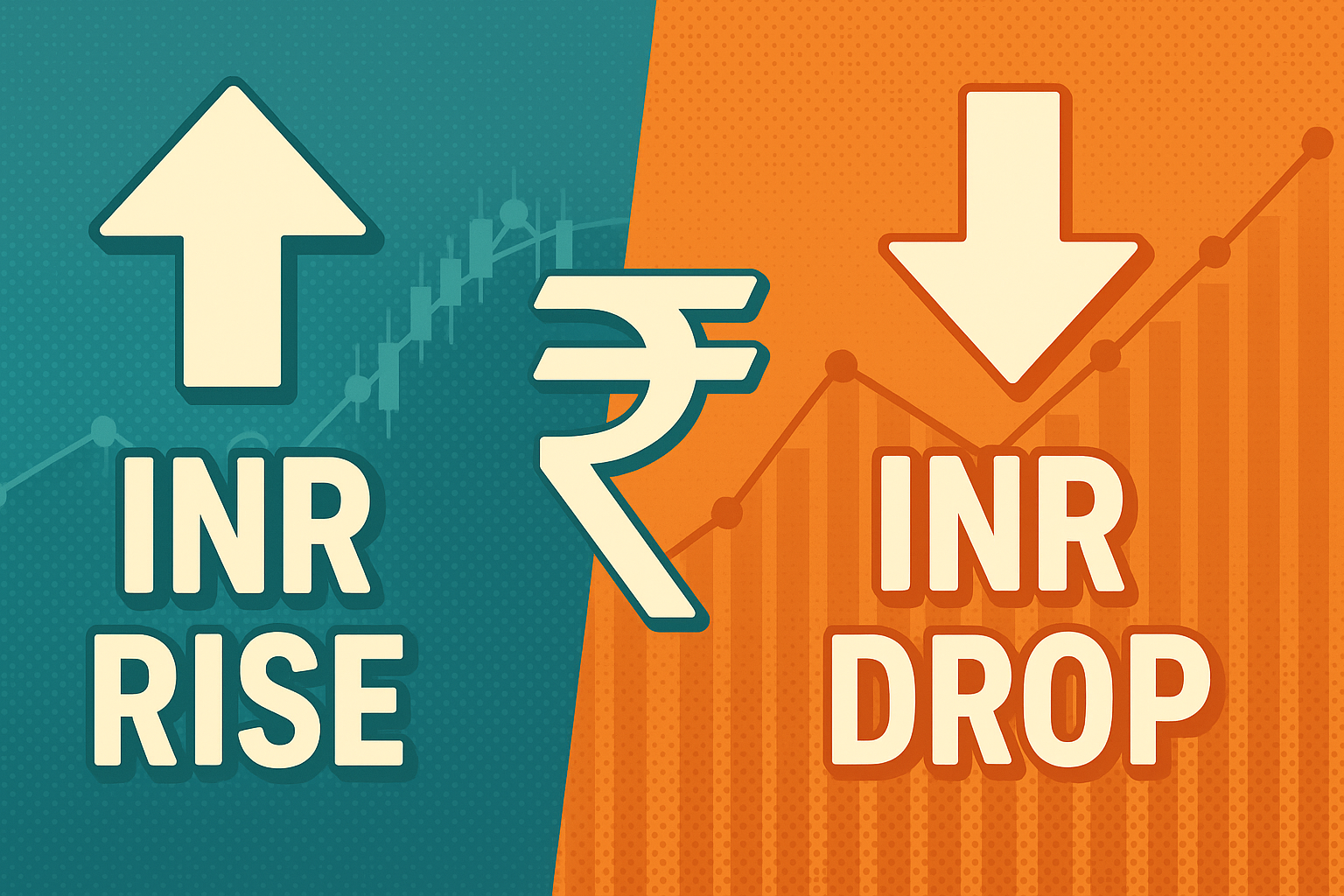The Indian rupee's weakness in 2025 is the result of a squeeze between stronger dollar dynamics, renewed U.S.–India trade tensions and tariff risks, persistent import demand (notably oil), intermittent foreign capital outflows, and more.
Together, these forces have pushed USD/INR to the mid-80s to high-80s level, and while temporary policy moves can stabilise the rupee, structural pressures mean volatility could persist.
In this article, we will analyse the underlying factors contributing to the rupee's decline against the dollar in 2025, the duration of the rupee's weakness, and insights for investors and traders.
Why Rupee Is Falling Against Dollar in 2025? 7 Key Reasons

1) Global Monetary Policy and the Dollar
The single most vital background driver for emerging-market currencies in 2025 has been the U.S. policy and the dollar's behaviour. Discussion of a more gradual approach to Fed cuts in mid-2025 caused the dollar to rise, as the timing for reductions was pushed back, and real yields remained high.
When U.S. interest-rate expectations firm up, dollar assets become more attractive and capital rebalances away from higher-risk emerging-market assets, pushing USD/INR up.
Markets adjusted rapidly in late July when futures trimmed the odds of near-term cuts, prompting renewed dollar strength and pressure on the rupee.
2) Trade and Tariff Shocks
In 2025, the rupee's weakness was amplified by an abrupt escalation in trade tensions as the U.S. announced higher tariffs affecting numerous trading partners, including India.
Markets reacted to the uncertainty: capital flows slowed, the cost of India's imports (particularly energy) came under new scrutiny, and firms facing potential tariff-induced margin squeezes created an environment where foreign investors re-priced risk.
Financial markets frequently react to policy shocks more quickly than governments can act, which is the case here, as the rupee experienced that pressure.
3) Strong Import Demand
India imports around 80–85% of its crude oil needs. When global oil prices increase or when importers rush to buy (due to sanctions, changes in supply sources, or to establish strategic stockpiles), the nation's dollar demand spikes.
In 2025, a combination of geopolitical strain and rerouting of oil supplies raised import bills and increased near-term dollar demand from state oil companies and private refiners.
This import demand can overwhelm portfolio inflows on any given day, creating spot rupee weakness even if portfolio flows later reverse.
4) Capital Flows
Foreign portfolio flows remain a big part of rupee dynamics. While FPIs returned to buying India earlier in 2025, sentiment can flip quickly.
Throughout July and early August, concerns regarding tariffs and global monetary policies led to intermittent equity outflows and increased demand for dollar liquidity.
Even modest monthly outflows can matter because India's onshore FX market is not as deep as major developed markets; sudden reversals or even the threat of reversals can widen USD/INR moves and forward premiums.
5) RBI Intervention, Reserves and FX Market Operations
To prevent disorderly moves, the Reserve Bank of India has stepped into the market multiple times in 2025. The central bank used both spot interventions (selling dollars) and operations in non-deliverable forwards (NDFs) to manage smoothness.
That activity, helpful for averting record intraday lows, also draws down reserves when intervention is sustained. Recent weeks saw the RBI use reserves to stabilise the rupee, and official data show reserves moving from the all-time highs recorded in 2024 into somewhat lower but still robust levels in mid-2025.
6) Rupee Forward Markets and Implied Depreciation
Forward premiums have risen: the market is pricing in higher expected INR depreciation over 1-year horizons compared with earlier in 2025. That shift reflects expectations about the dollar, macro uncertainty, and near-term import financing.
An increased forward cost can contribute to greater spot weakness, as corporations and banks hedge future dollar requirements at elevated rates, securing pricier imports and transmitting costs to the economy.
Dealers reported a noticeable increase in 1-year implied yields and forward premiums in early August.
7) Domestic Monetary and Fiscal Interplay
Monetary policy in India, whether the RBI is leaning toward loosening or tightening, interacts with global rates to determine real yield differentials.
If Indian yields fall or if inflation expectations rise faster than nominal rates, the relative attractiveness of INR assets declines. Fiscal pressures (deficit financing needs) and large public-sector borrowing programs can also influence market sentiment.
In 2025, while India managed to maintain a relatively low inflation rate, fiscal discipline and the behaviour of yields were monitored closely; markets responded to any indications that the government's financing requirements could lead to higher interest rates or supply changes that might devalue the currency.
How Bad Is INR Falling? Quick Fact Check

As of early August 2025, USD/INR has been trading around ₹87–88 per dollar, with several intraday tests of record territory and weekly drops of roughly 1–2% as markets digest headlines and flows.
India's foreign exchange reserves have also decreased in recent weeks due to RBI actions aimed at stabilising the currency, having reached their highest point in 2024.
The adjustments to reserves, although historically at comfortable levels, highlight the central bank's active management of volatility.
Scenarios That Could Stabilise or Further Weaken the Rupee

Stabilisation Scenarios:
Clear diplomatic progress on trade tensions or tariff rollbacks that reduce export uncertainty.
Sustained foreign inflows (FPIs and FDI) are returning to growth and valuation narratives.
RBI signalling and executing gradual FX market sterilisation, combined with modest policy adjustments that keep yields attractive.
Downside Scenarios:
Prolonged tariff escalation dents exports and investor confidence.
A sharp rise in oil prices or a forced shift to more expensive suppliers.
A global risk-off episode that drains EM funding and causes sustained FPI outflows.
Practical Takeaways for Investors and Traders
For investors, diversify across asset classes. If you are long Indian equities, be aware that sudden rupee weakness can pressure returns in INR terms even if asset prices are steady in dollar terms. Monitor RBI moves and Fed expectations.
For portfolio managers, reevaluate currency exposure and conduct stress tests on portfolios in scenarios involving additional depreciation and increased volatility.
Consider using selective hedges (currency futures/options) and increasing allocations to assets that benefit from a weaker INR (exporters, some commodity producers) while staying mindful of valuation.
To reinforce your upcoming decision, watch these closely as they directly influence dollar/rupee dynamics in the near term:
U.S. employment and inflation data
RBI policy statements and FX reserve updates
Trade/tariff headlines
Oil price shifts and supply news
FPI flow data
Conclusion
In conclusion, it's improbable that one factor will instantly reverse the rupee's weakness by 2025. The most probable path is periodic bouts of volatility punctuated by RBI support and episodic recoveries when global risk sentiment improves.
However, if tariffs persist and global headwinds continue, the rupee could remain under pressure and exhibit higher forward premiums for some months.
Disclaimer: This material is for general information purposes only and is not intended as (and should not be considered to be) financial, investment or other advice on which reliance should be placed. No opinion given in the material constitutes a recommendation by EBC or the author that any particular investment, security, transaction or investment strategy is suitable for any specific person.









